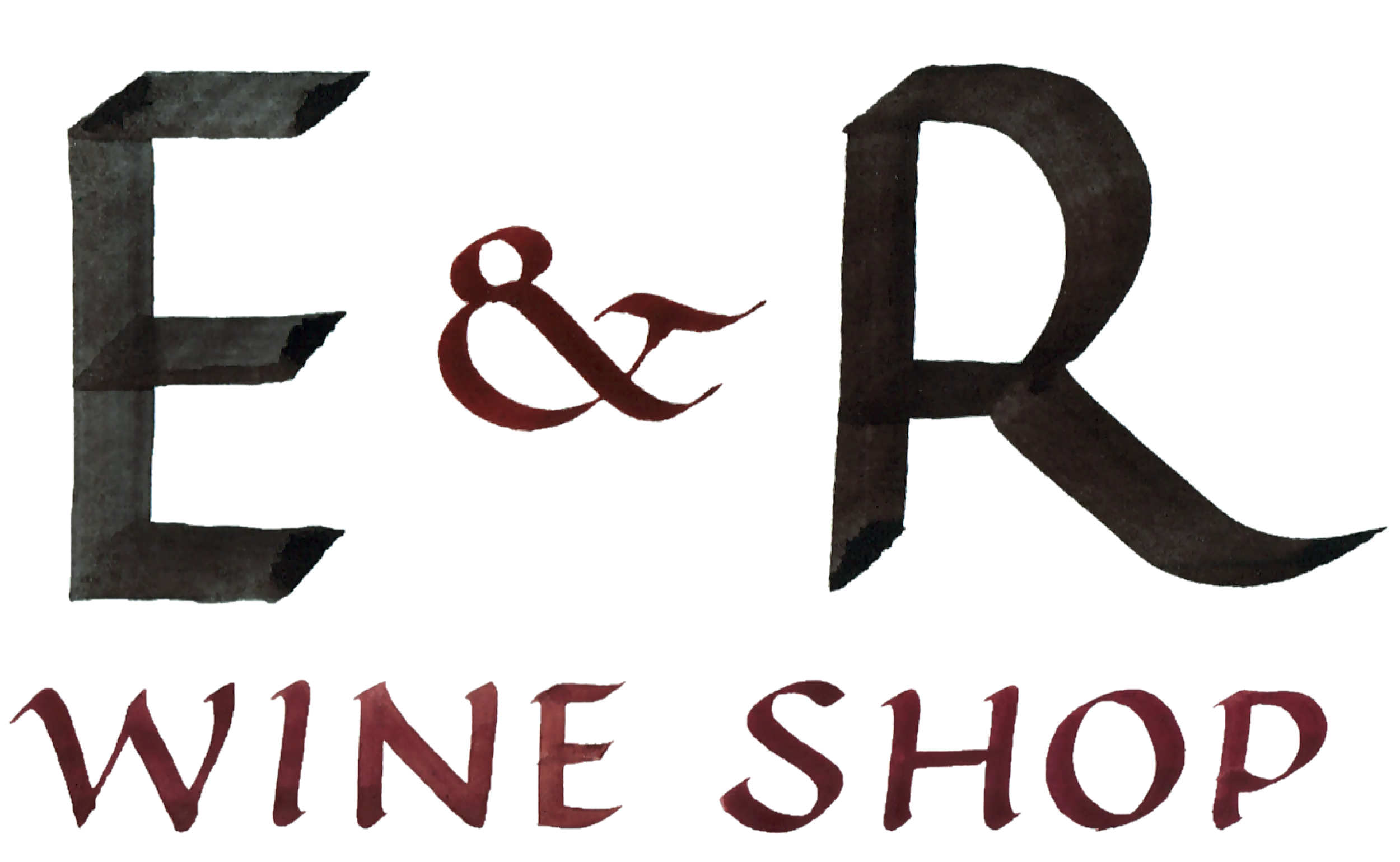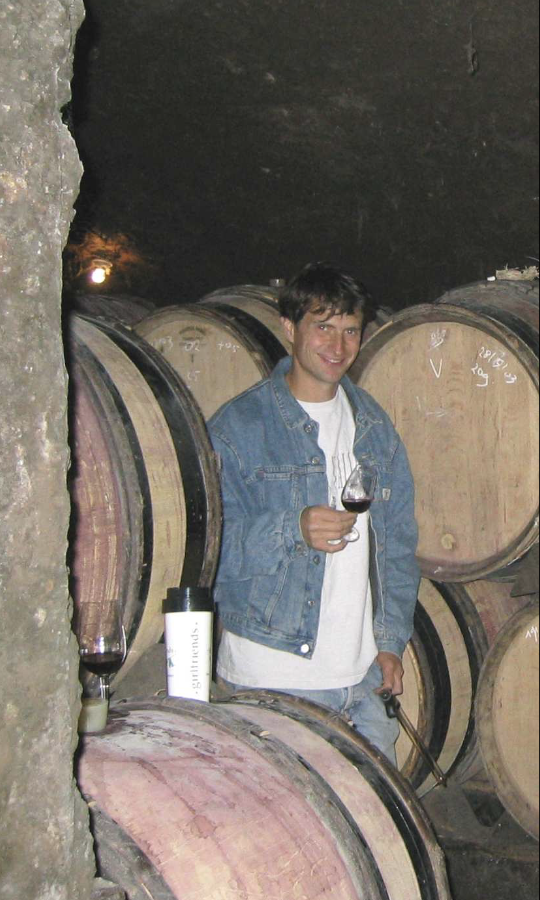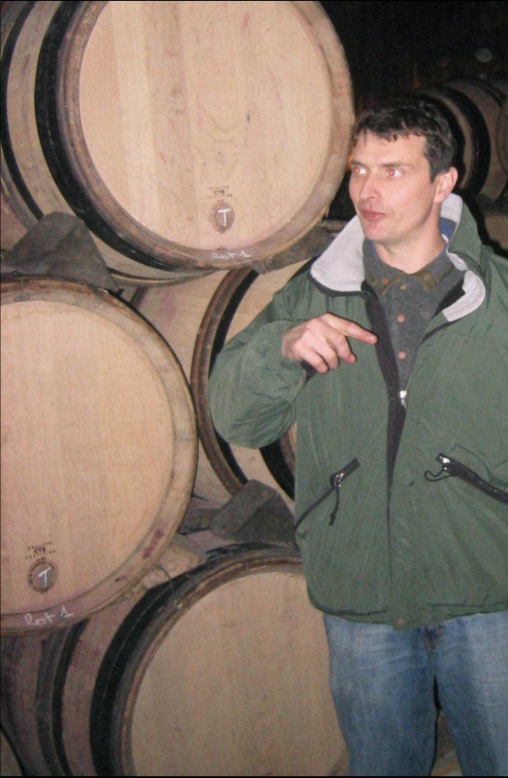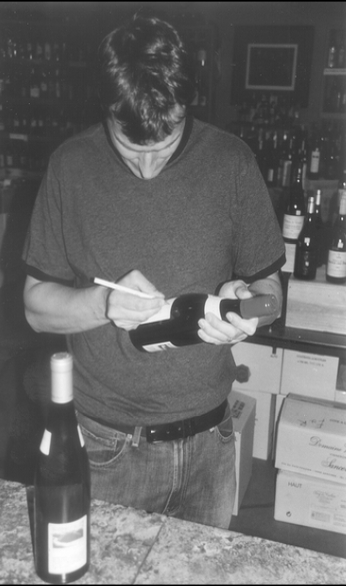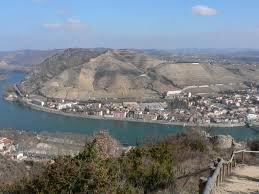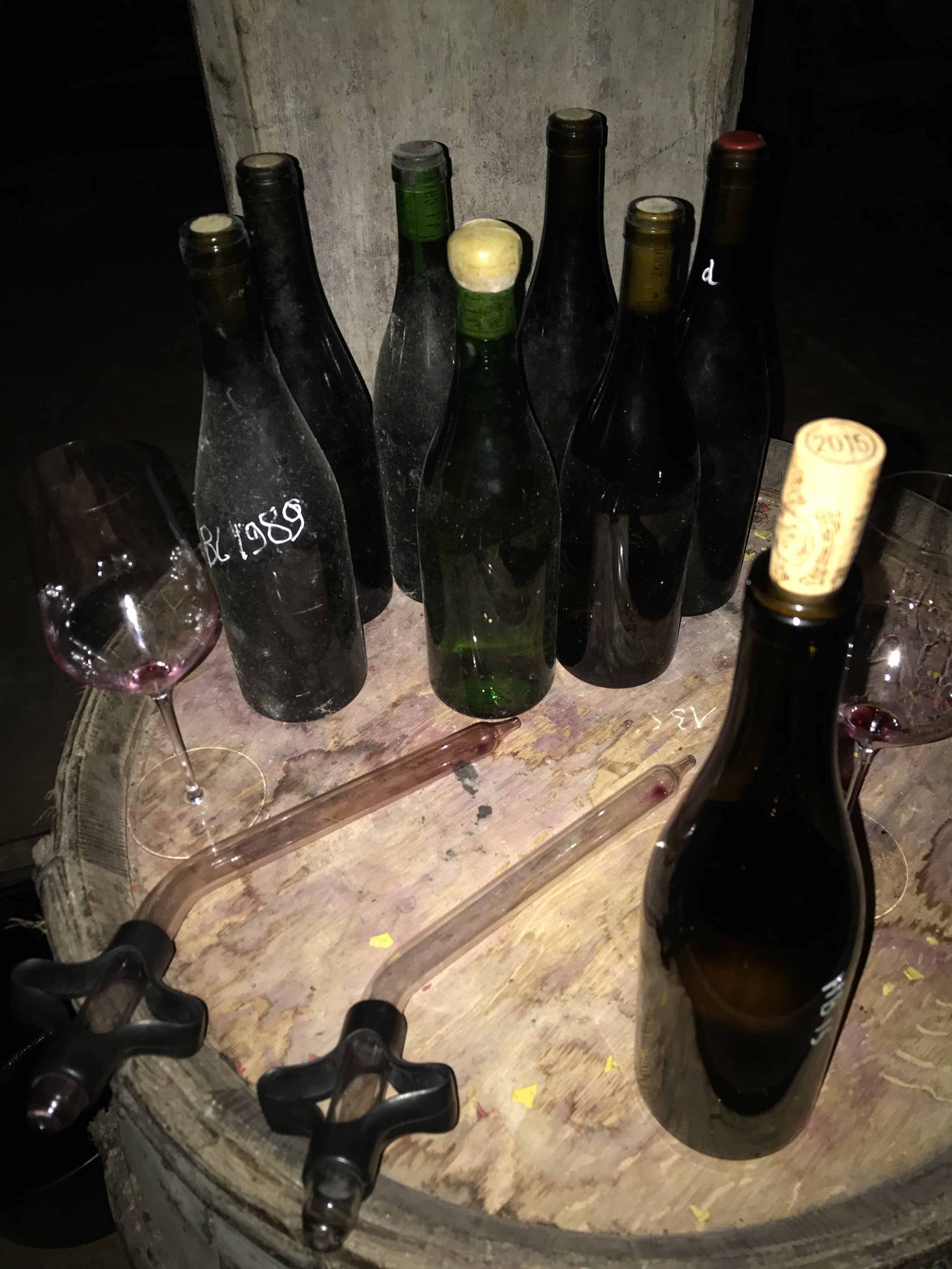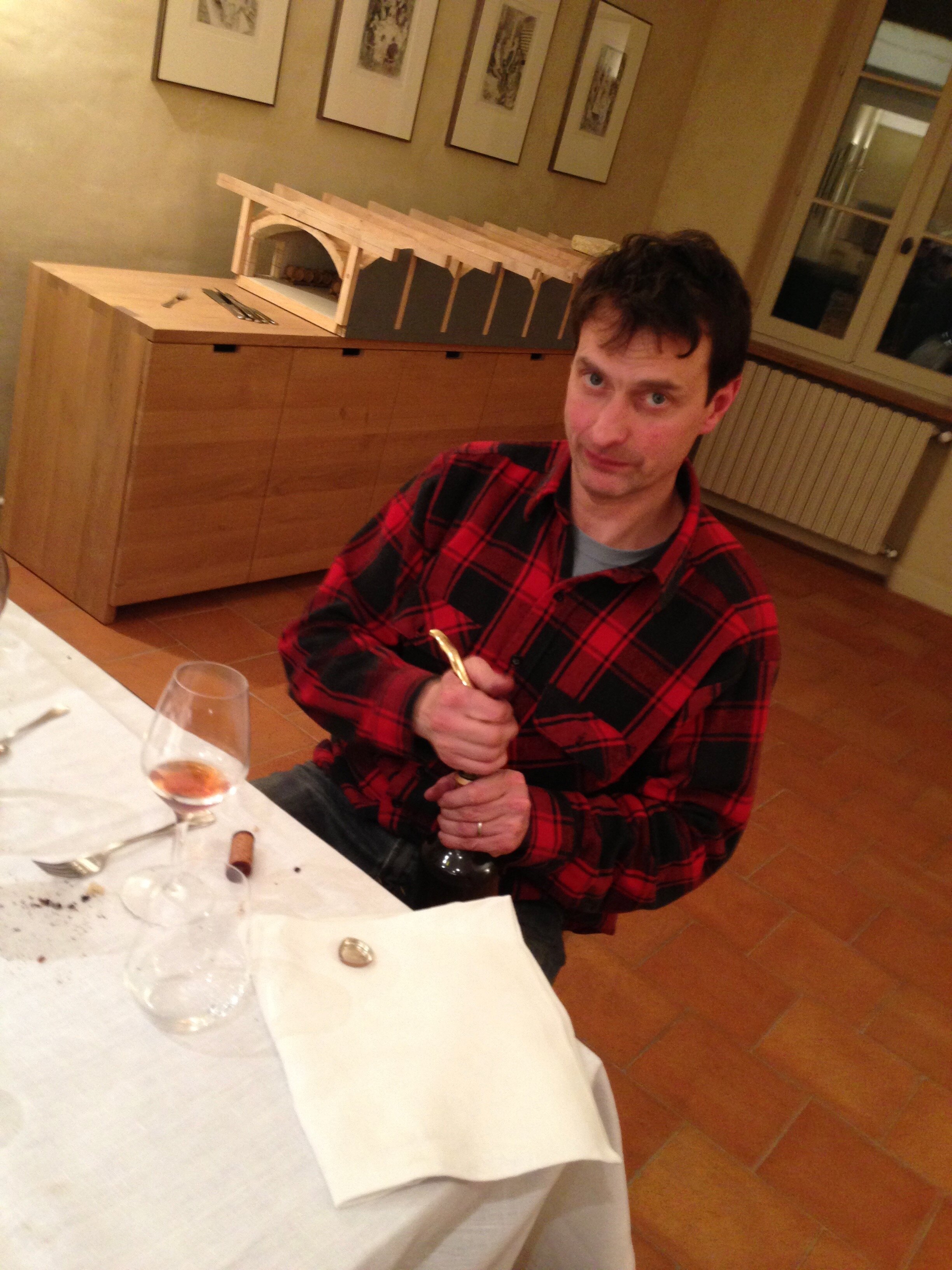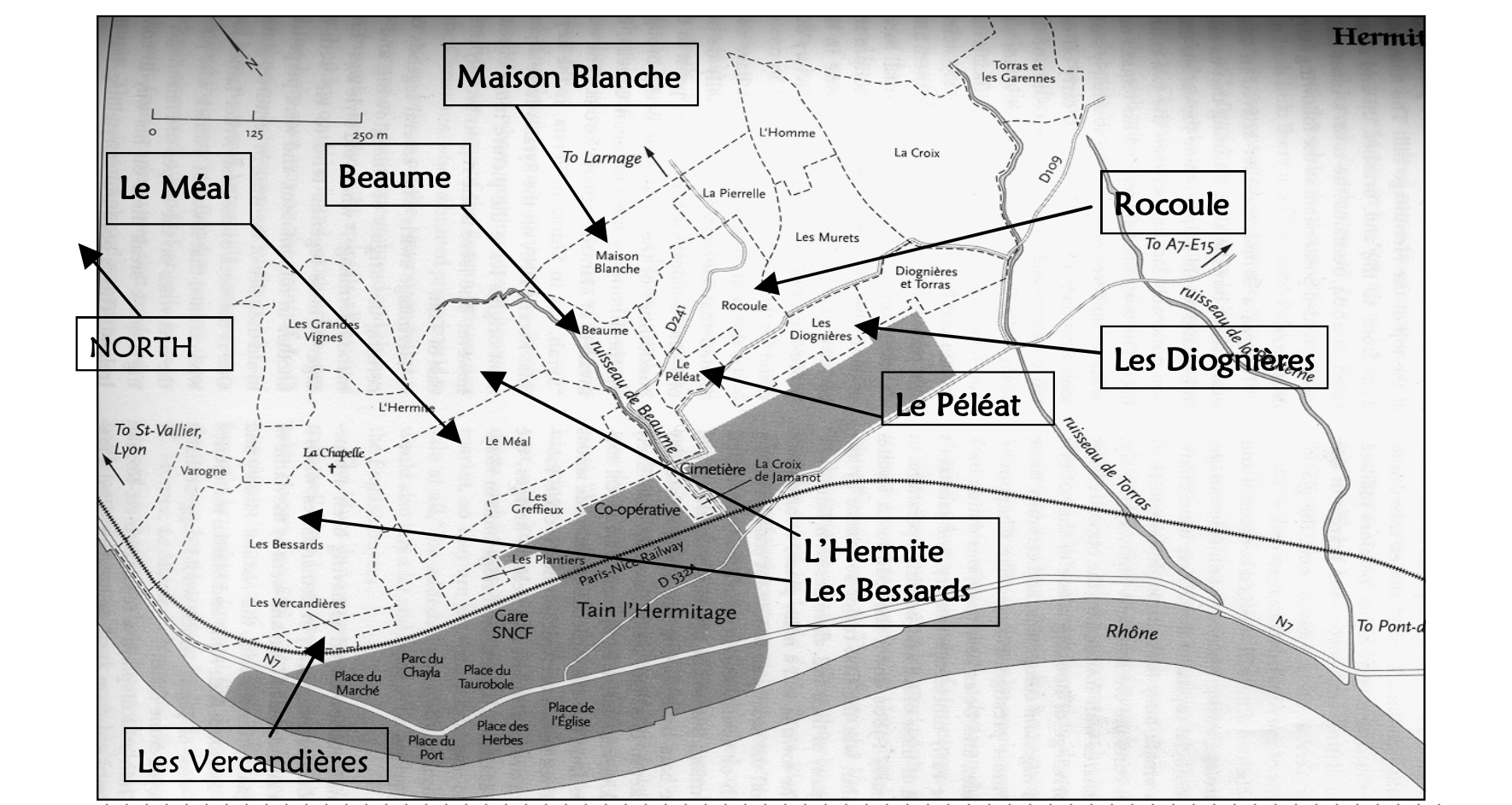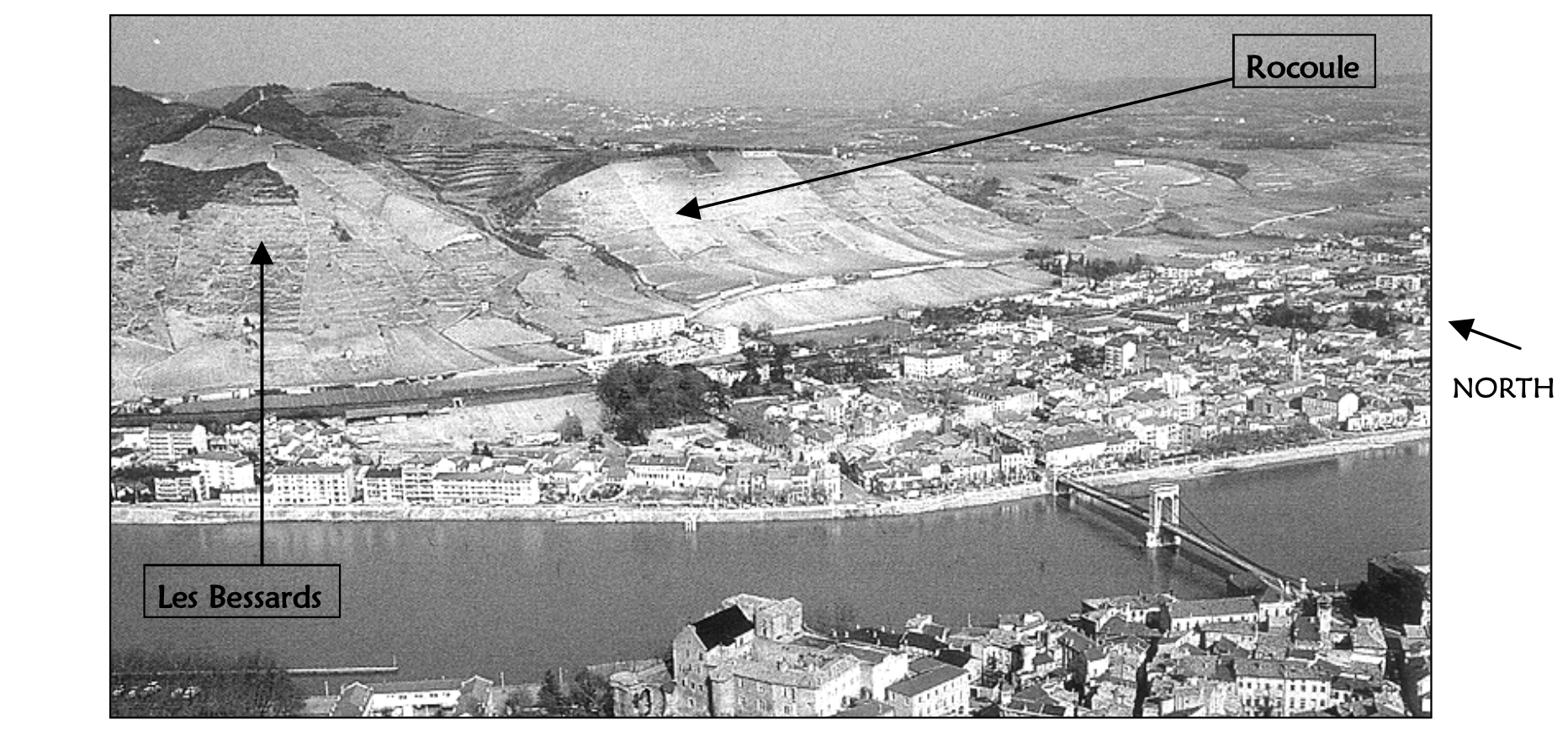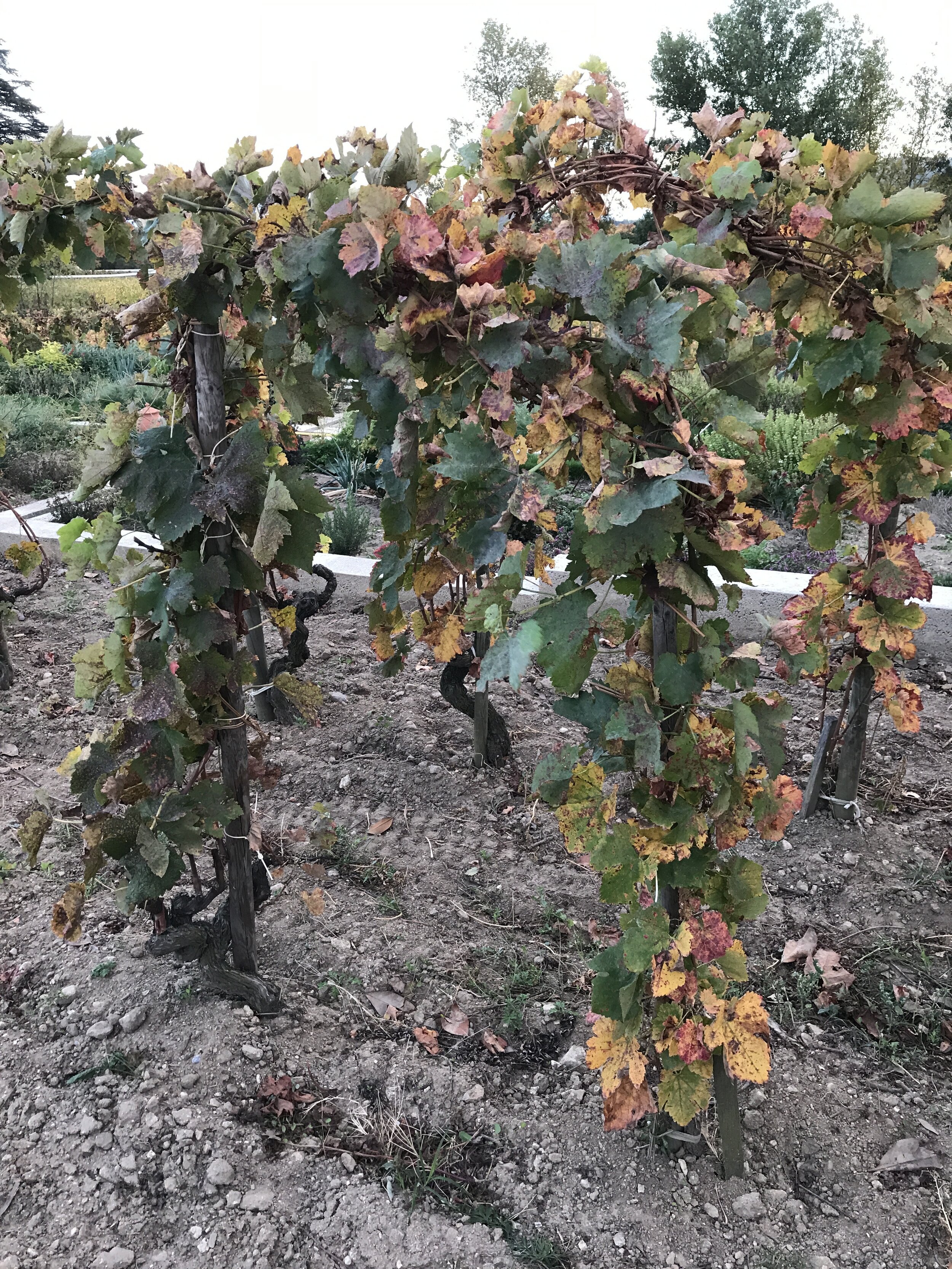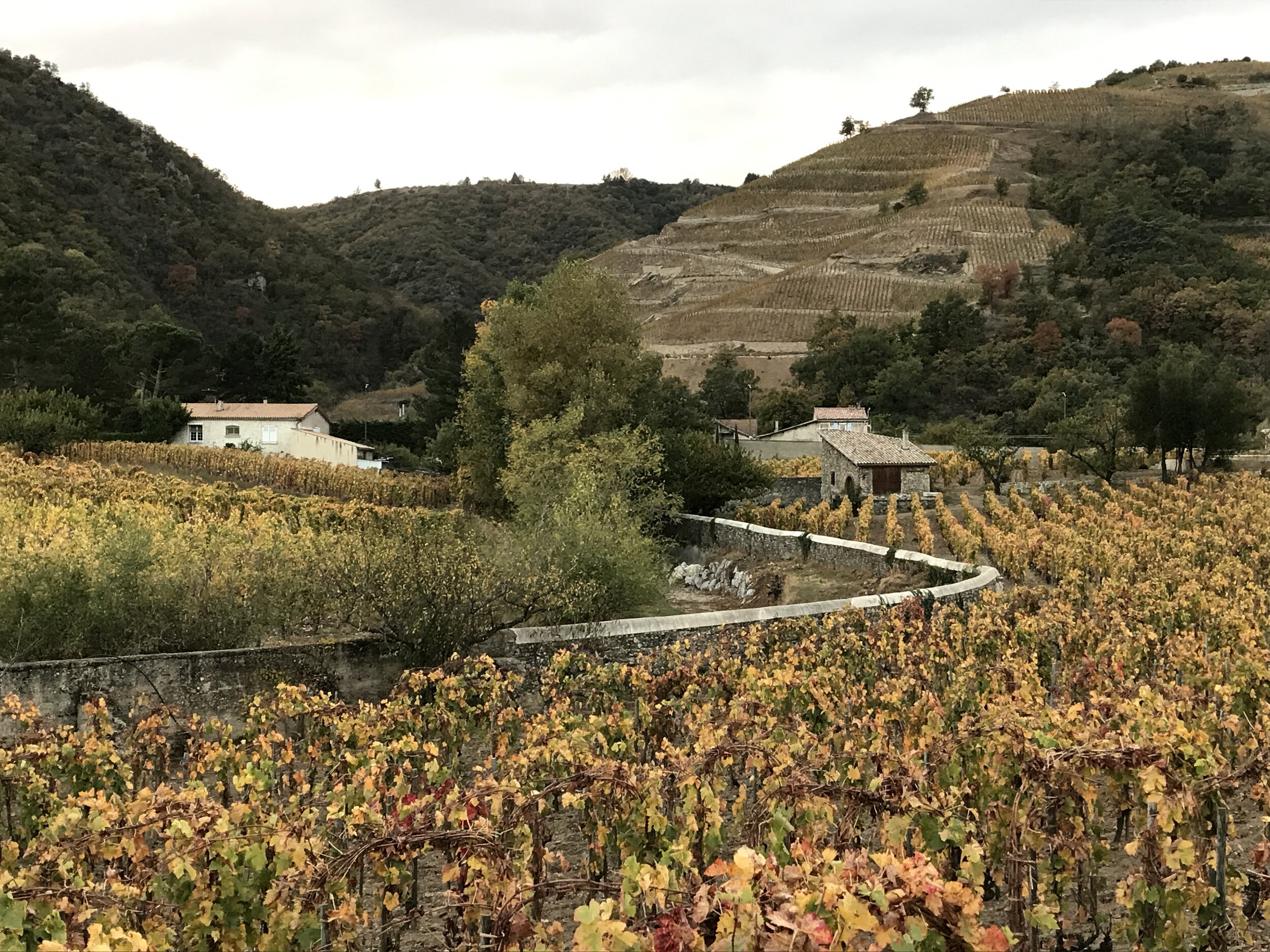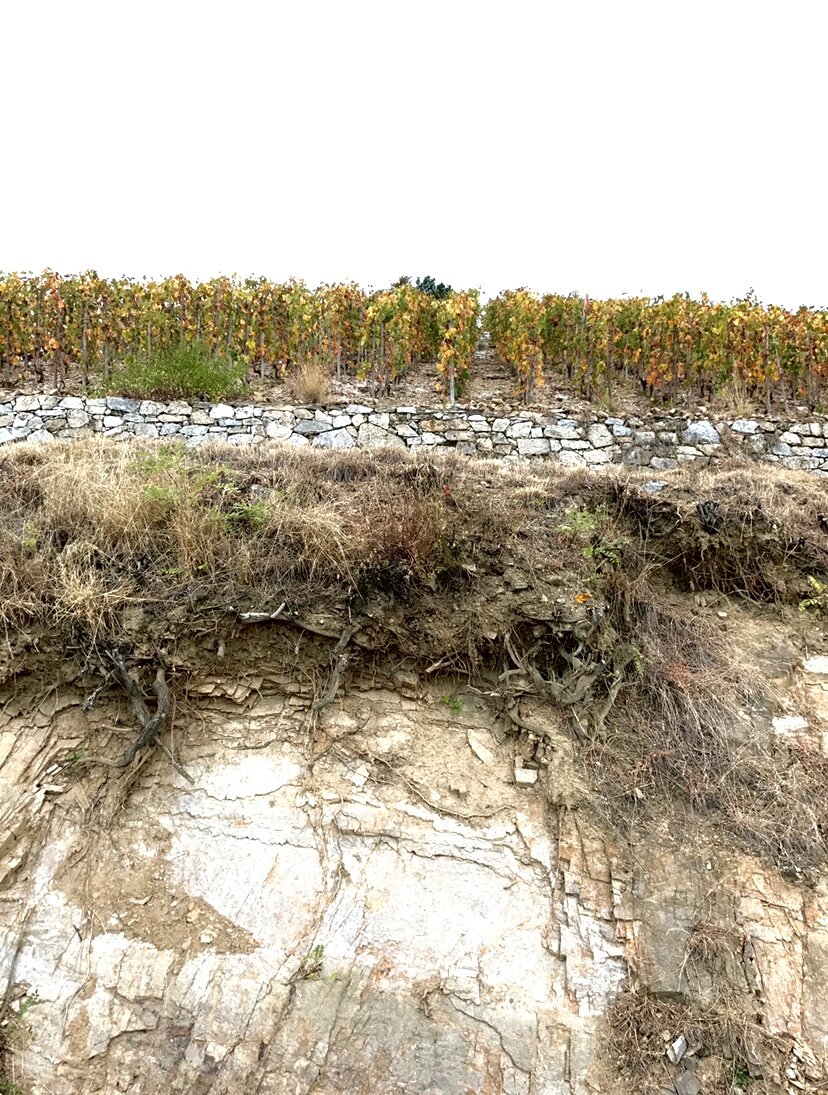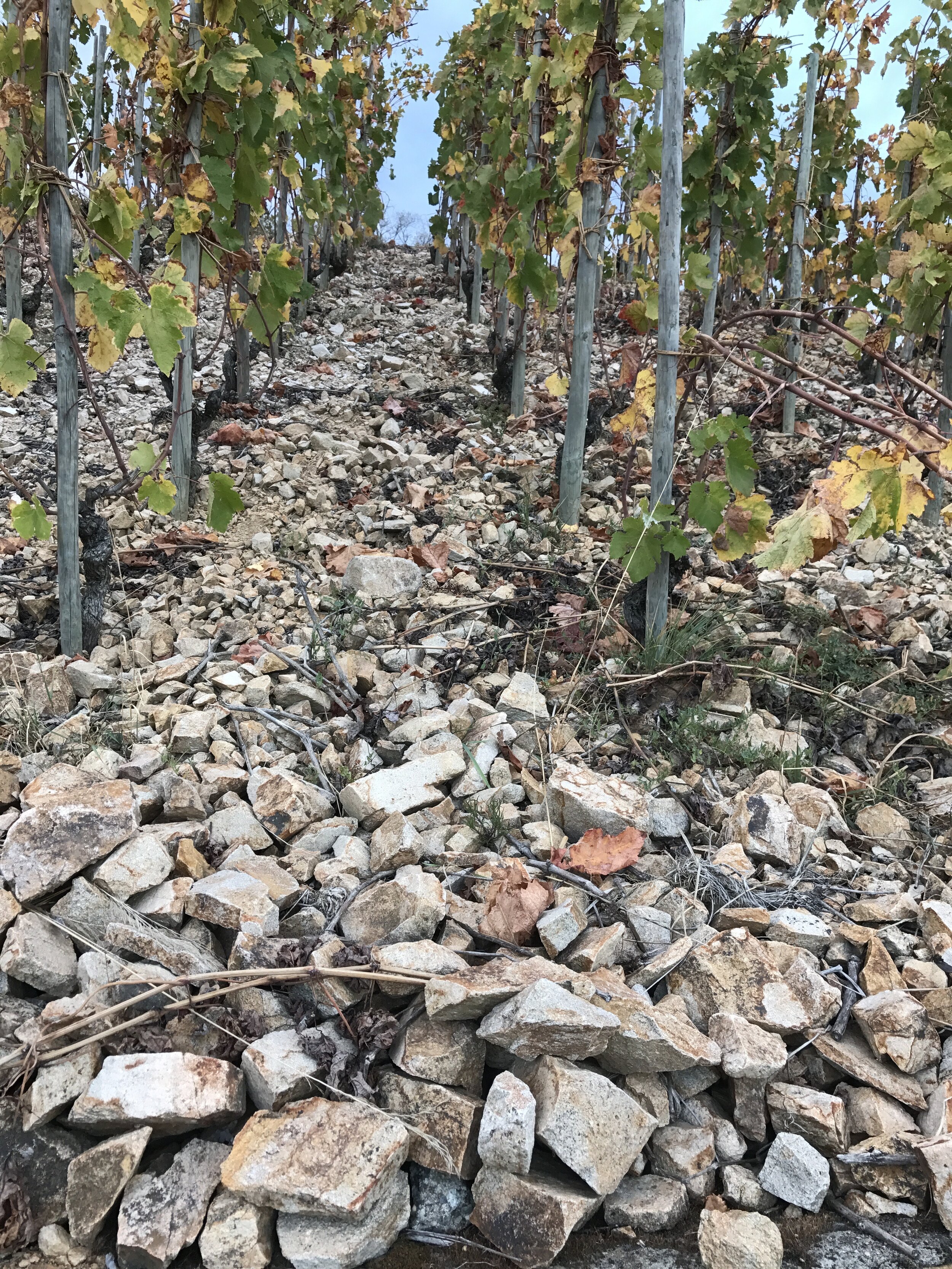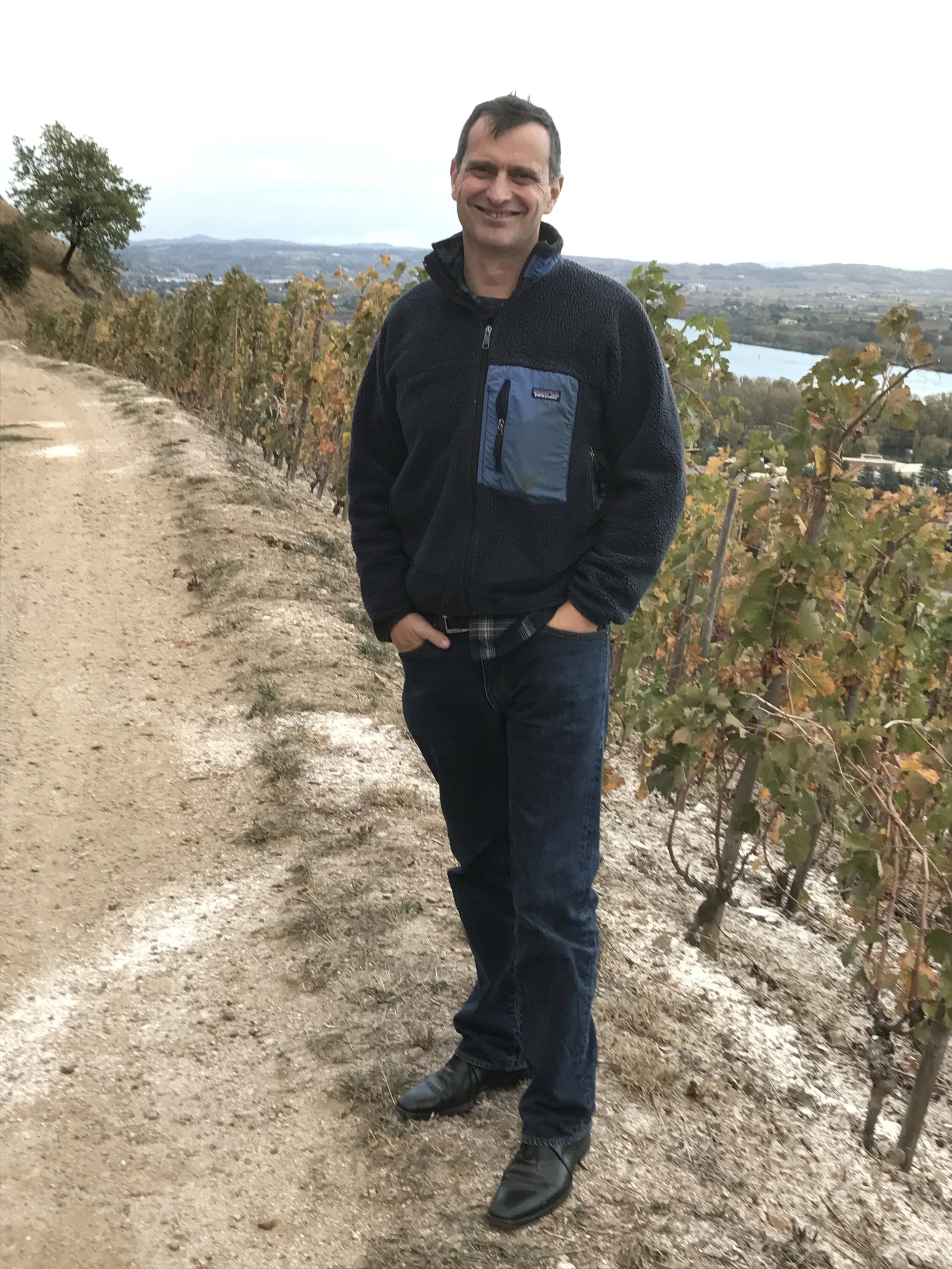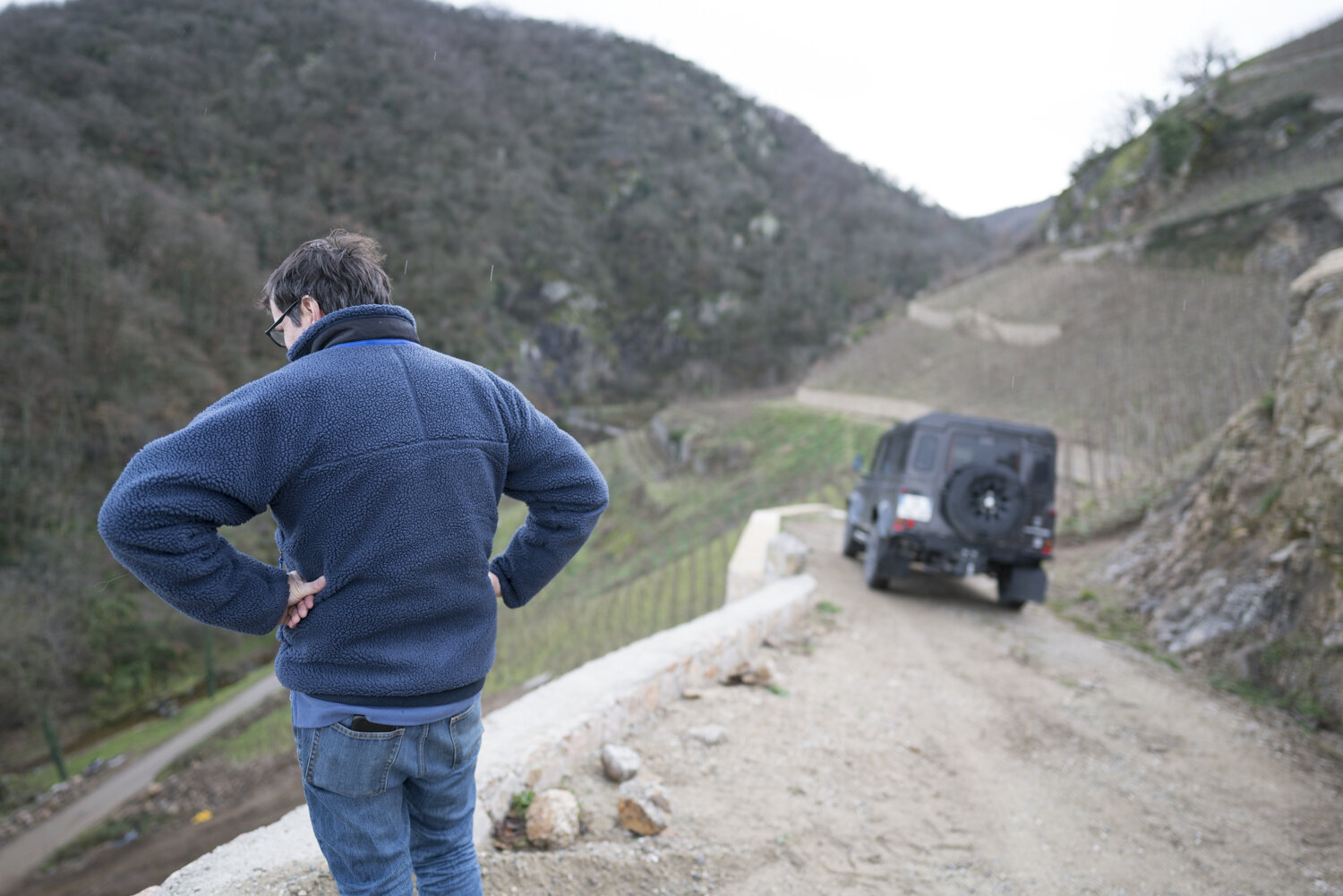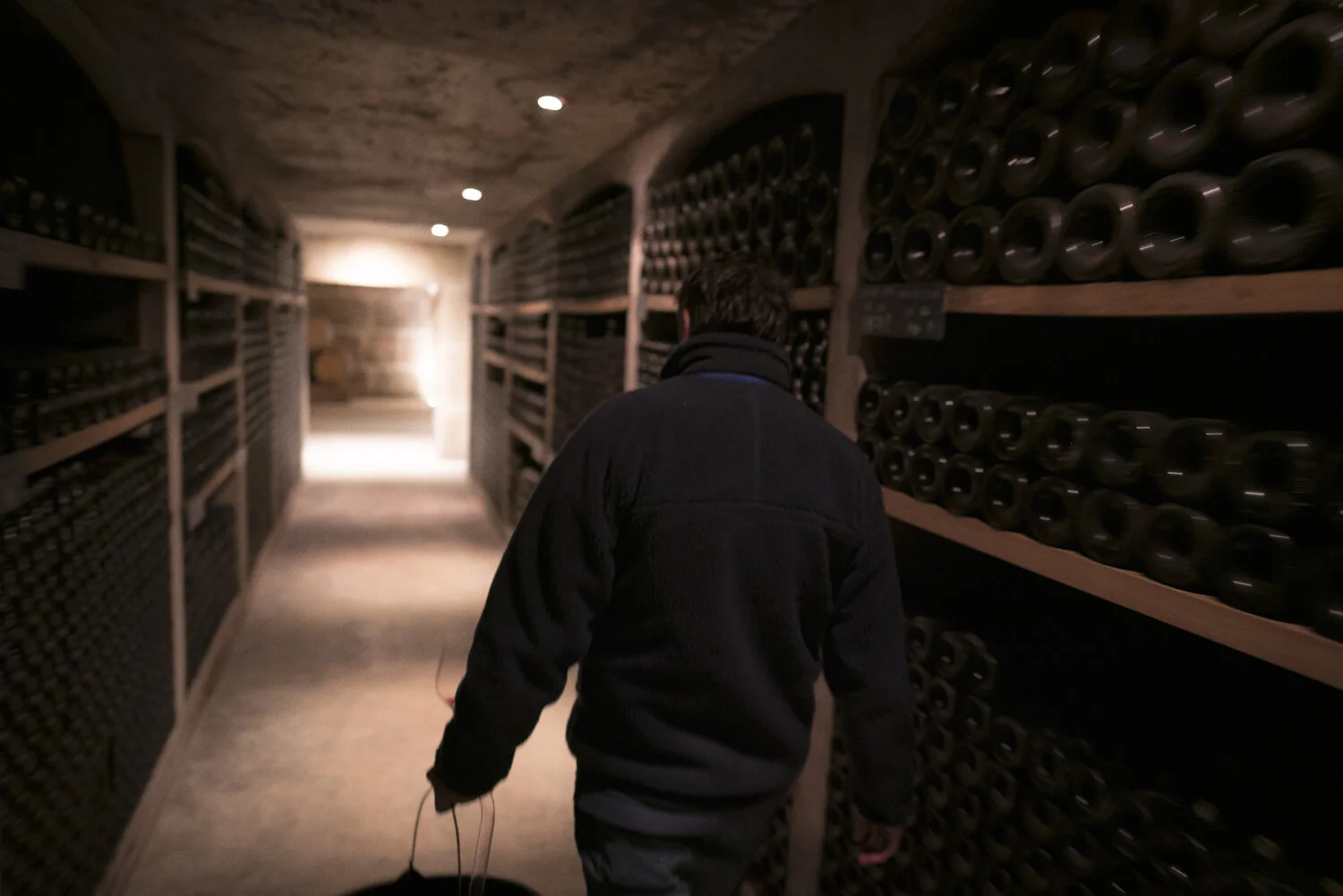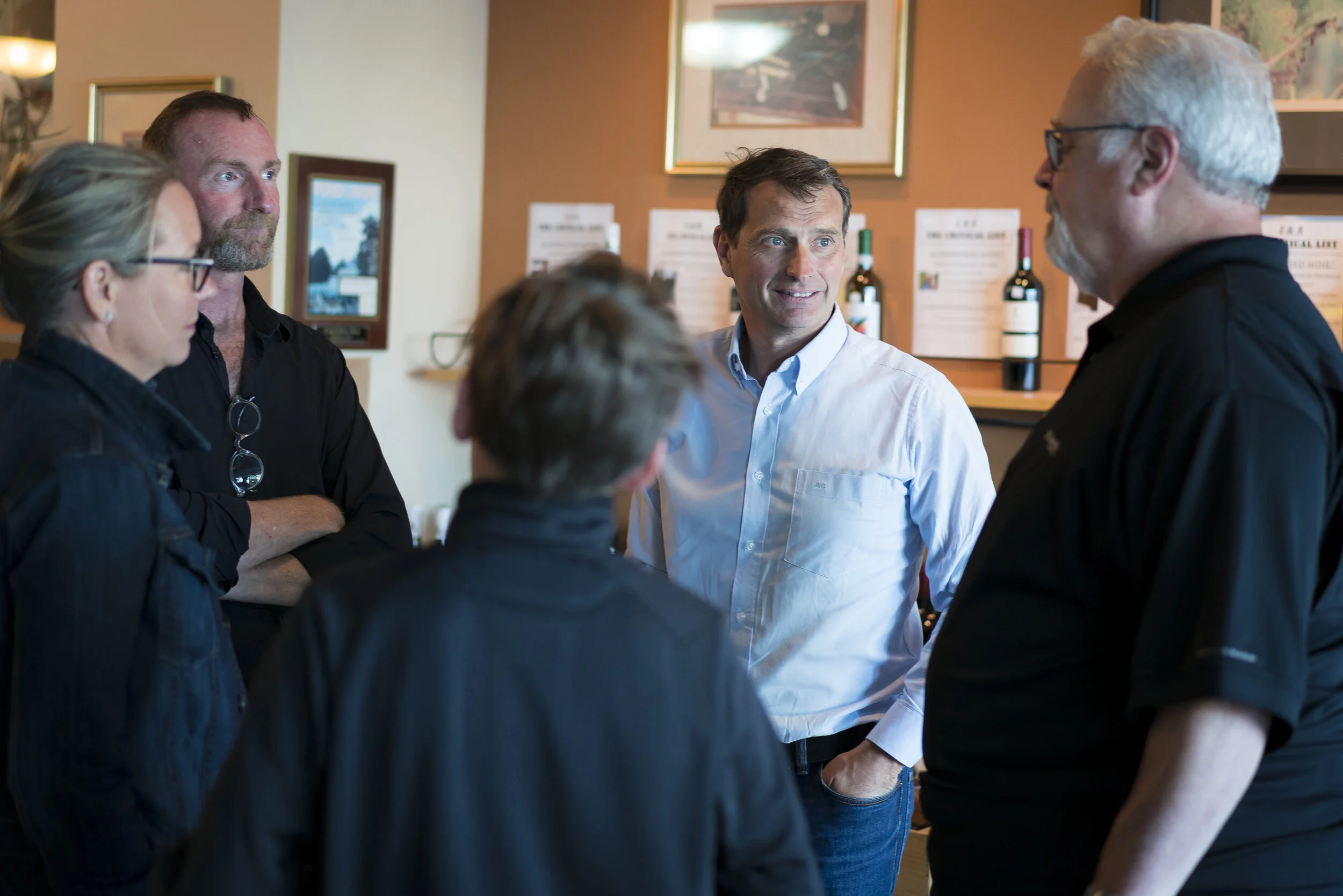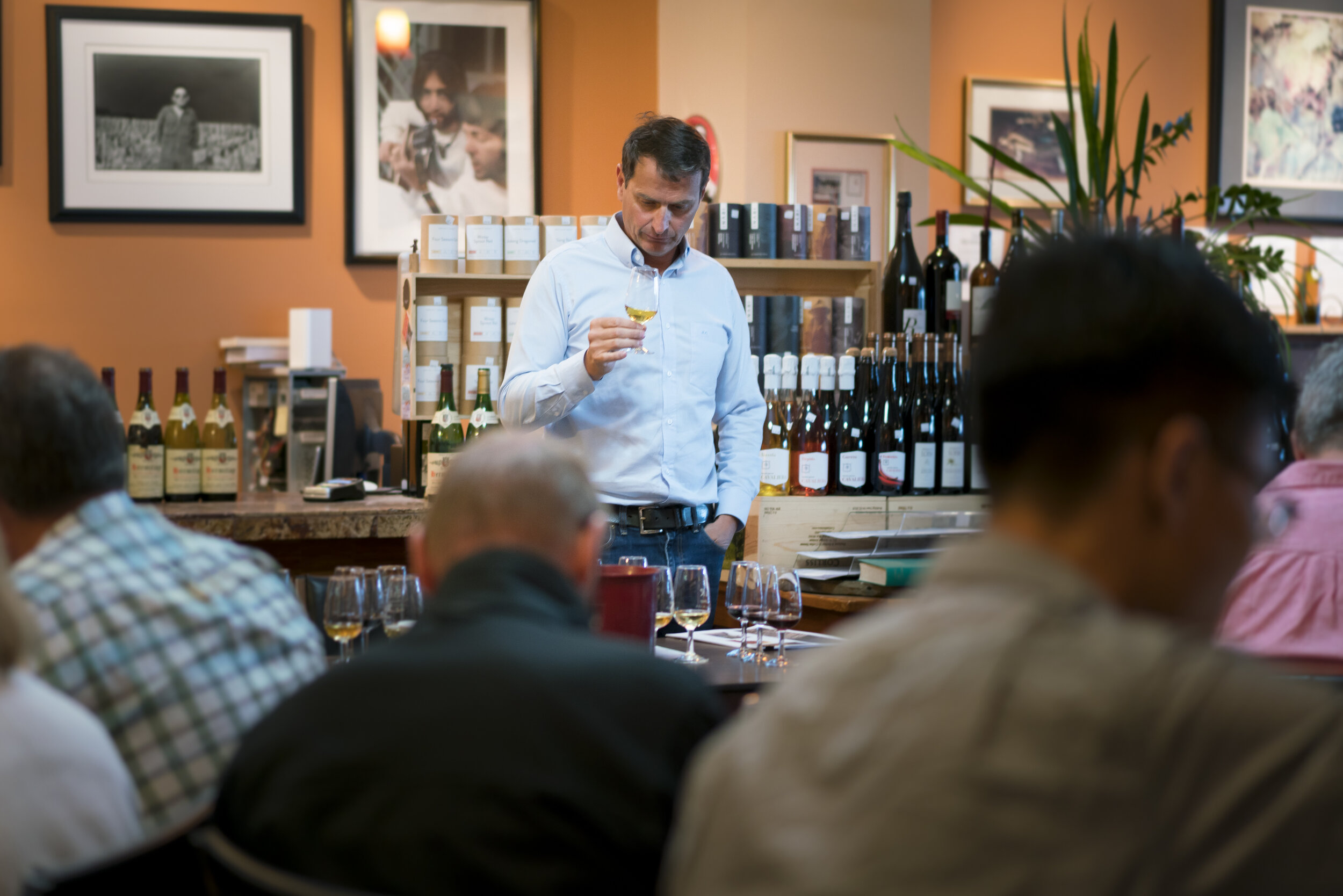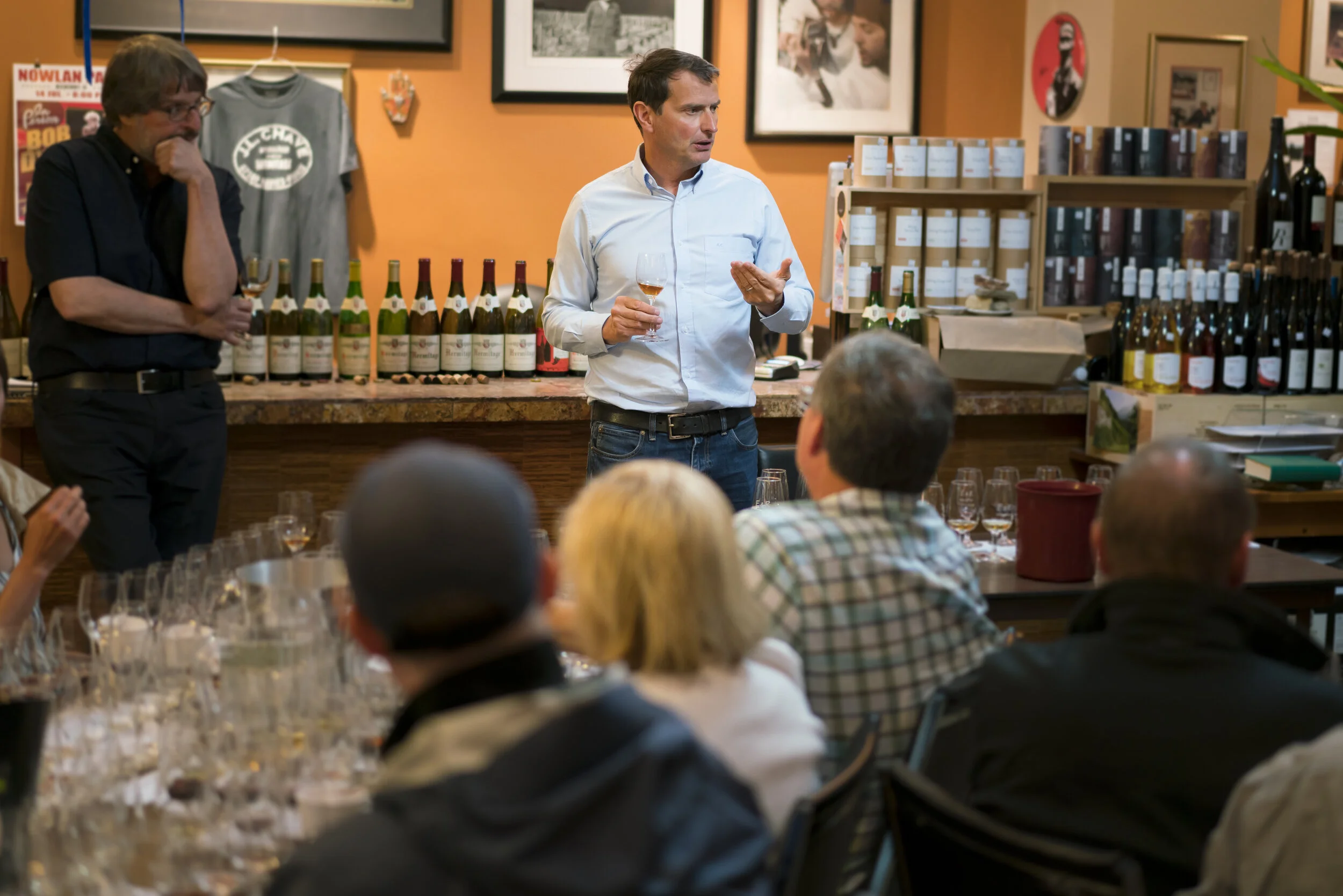Domaine Jean-Louis Chave - Mauves, France
Tasting the individual parcels of the rouge in the cellar with Jean-Louis Chave, February 2020.
What follows is most of our special Domaine Jean-Louis Chave issue - “The E&R Domaine Chave Explorer” - from 2007. Along the way there are updates as this is a living article. Most recently in the lat summer of 2019 Jean-Louis, Erin, Louis and Emma Chave made a special rip to the shop to help us celebrate our 20th Anniversary. Some photos are at the end of this article.
“TIME IS NOTHING”
“We shall not cease from exploration
And the end of all our exploring
Will be to arrive where we started
And know the place for the first time. “
-Thomas Stearns Eliot (St. Louis, Missouri): Four Quartets
This is the first E&R Wine Explorer devoted entirely to one property. Domaine Jean-Louis Chave defines Hermitage; an exceptional appellation in the wine world. It accomplishes a feat few if any other wineries achieve in producing a spectacular white wine, an extraordi- nary red wine, and a phenomenal sweet wine. Making any great wine is rare, producing one of each is messing with the supernatural.
There is a barrel full of trouble with “great” wine though. Over the years it has become increasingly clear to me that to approach a complete appreciation of a great wine you need to know its expression; its truth. You need to go to the place where the wine is made and walk through the vineyards, you must visit the winery and taste the wine with the wine- maker. You cannot get closer unless you know the wine young, and when it is mature. You must know the least of these wines as well as the best of them. In so doing you will be less surprised to know that the winemaker prefers his 2002 from a tough harvest to the 2003 that got 99 and 100 points from virtually every wine publication on the planet. Who is correct is the one coming closest to the truth of the wine itself and nothing more.
Consider this from current Domaine Chave winemaker Jean-Louis Chave:
“Hermitage is an expression of this place, not of a grape.”
Domaine Chave is the story of defining an entire appellation while re-defining another. It is a chronicle of and about time, and it is a tale of rebuilding a potent ancient landscape from disuse. Also here is a story of extraordinary artistic capability in working with nature, and a story of near scientific ability in comprehending the ground the grapes grow in. The present day Domaine Chave is all about two remarkable men who in this flashbulb world of gigabytes, sound bits, and hard drives favor what they do and how they achieve it, far above paying attention to what any wine critic or publication writes about them. Though venerated in all places where wines are enjoyed, Domaine Chave’s tiny production is considerably larger than their collective ego; quite the reverse of other celebrated wineries.
From over the years.
A STORY WITH 2 BEGINNINGS: ONE IN 1481, AND ANOTHER IN 1990
BEGINNING # 1.
(1481) “Services rendered” to one Seigneur d’Yserand by Charles Chave are exchanged for a nearby hillside property in Lemps, a 20 minute horse ride north from the tiny village of Mauves in the central Rhone Valley. These new slopes and vines now owned by the Chave family behold a beautiful panorama across the Rhone River, westward toward the grand hill of Hermitage. That view to Hermitage was much like the one in the pictured on page 17 (with fewer buildings). Roughly some 390 years later when phylloxera struck their vines the family moved off the Lemps hillside. They settled on a narrow flat along the west bank of the Rhone called Mauves. Later on, this area became classified as part of the original Saint-Joseph appellation. Across the Rhone from Mauves, just above the village of Tain l’Hermitage, is the scenic two-mile sweep of hills making up the present day “Hermitage” appellation. Over time Chave’s family vineyard holdings increased to 35 acres (11% of the appellation) making them the largest family landowners of the tiny geography of Hermitage, while three large wine companies (Chapoutier, Jaboulet, Delas) dominate nearly 70% of the hill as of 2007. The breadth of the more modest Chave holdings is key.
509 vintages after Charles Chave’s exchange, his descendants had become famous throughout the wine world, yet, as you will see in BEGINNING #2, they still had to pick up their own mail each day down at the local “poste”.
BEGINNING #2.
(March 1990) Confused, close by but lost, sitting in our car in two-horse town Mauves, a woman rides by my wife and I on a bicycle—she is heading to the nearby “poste”. (The streets in pocket-sized Mauves, in France’s Ardèche Department are narrow—built just wide enough for two horse-drawn carriages to pass each other with a bit of extra room.) The cyclist picks up more mail than anyone else in town—still does. Postmarks from Argentina, Germany, Japan, San Francisco, Slovenia, South Africa, Paris, Portland... Ironically, sort of, after we finally found the front door, and waiting under the famed sign that everyone misses the first time they visit, it turns out this same lady is now riding her bike right back toward us. She is smiling. Indeed it is the person we came to see! “Madame Chave”.
Chave sign.
Monique Chave is a lovely, bright, articulate woman; the wife of winemaker Gérard Chave of Domaine Jean-Louis Chave. Their 22 year old son, Jean-Louis (JL) is away this particular day.
Thus BEGINNING #2 begins for me; the first of eight Domaine visits over the ensuing seventeen years. On this first visit, Gérard Chave (today 72), was fifty-five years old and had been at the Domaine since 1955, more or less taking over from his father Louis, in the early seventies. Though I never asked him his opinion, there is no doubt that this first visit took place in the same year as arguably the finest vintage presided over by Gérard until handing over the reins (more or less!) to JL in 1992.
During these quickly passing seventeen years the wines have not changed much at all; only getting even better. Gérard and Jean-Louis are constantly on the lookout for ways to improve their expressions of Hermitage. Jean-Louis, the Domaine’s name- sake, presides over the winery in the family’s 16th and 17th century cellars. With its perfect 365 day-a-year humidity and temperature, the place never seems to change. You can nearly sense it in that atmosphere, that consultation is the persuasive element of wisdom. It is safe to assume that at this address, aptly located at #37 Avenue de Saint-Joseph, critical choices take into account the views of father and son. (A further irony: the first small cross street just before the Domaine is the “Rue des Mûres”, or Wall Street; here, a stony and ironic double entendre.)
In 2003 Jean-Louis married St. Louis, Missouri’s Erin Cannon. Rounding out the triple crown “Louis” coincidence, the newest Chave; Louis, was born in April 2006. Louis is a charmer, and the threat of naming him J-Elvis seems to have passed. These days Domaine Chave produces about 4000 cases of Hermitage from its 35 acres, of which about two-thirds are red. The wines are shipped all around the world.
JEAN-LOUIS CHAVE: WHAT MAKES A GREAT WINE? “TRUTH”
The current Jean-Louis Chave, circa 1968, is taking all of the family’s past seriously and bringing it with him into each new day. His coach, mentor, debate partner, critic, and supporter, is also his father Gérard, the man who brought Domaine Chave to its current height as one of the world’s finest Estates. Papa Chave too, carried the past with him moving forward, and along with Monique; well... their boy Jean-Louis is one of a kind, a very very good kind for sure. JL is scholarly but warm, articulate but thoughtful, attentive but always consulting internally. When he speaks to you, you are the only person in the room, but as he speaks everyone in the room listens. For so many people, an accolade or two brings out the sunglasses and arrogance, but with Jean-Louis, who has phenomenal accolades from all across the globe, it is only about the land, the grapes, the wine, and expressing his beloved Hermitage, (and now Saint-Joseph too). His ego is invisible; he is one of those people that even Scrooge would warm up to.
While JL is not blinded by reverence for the history of his area, with his work with his negociant business (page 16), his astounding project in Saint-Joseph (page 14), and his mental acumen, he moves forward wisely. All of this is rolled up in an anecdote. During a recent visit along with a very accomplished and Rhone-wine-savvy friend of mine, we were discussing the appellation of Saint-Joseph with JL. My friend, who thinks very highly of a particular and well-known producer making a Saint-Joseph to the south of Mauves, asked about that wine. The reply was polite and respectful. In essence JL said that it is a very nice wine, but for him it is not “Saint-Joseph”. As he noted, historically— Saint-Joseph is from a few specific places. (More on this on pages 14-16.)The vineyard was created, and did not exist until fifty years ago or so. Vines had never been there before. Then, the vineyard has an eastern exposure, not a southern one like Hermitage, or the best Saint-Joseph sites. Lastly the soil there is Mostly limestone, while the finest soil in Saint-Joseph is granite-based. (Though JL respects the wine and the producer, other than its history, soil and exposure, it is not quite his idea of the appellation.) I have come to learn the wine JL looks to make must necessarily be as articulate and expressive as he himself is.
JL attended school in America, receiving an MBA in of Hartford and took a number of U.C. Davis California courses. (Not easy to do if your native language is not English.) He has been to the USA many times, including Portland and E&R, and we hope to host him in a tasting of his wines in the not too distant future. His experi- ences in America make him recognize even more clearly the importance, standing, obligation, and tradition he upholds as current caretaker at Domaine J-L Chave.
A hallmark of the man is his openness and unending curiosity in blending history and modernity as skillfully as he blends his Hermitage. All good things in good time, I think, so it is no surprise to note that the first thing Jean-Louis says when I ask him what makes a great wine?, is “truth”.
HERMITAGE & CHAVE; “WE DO NOT MAKE SYRAH, WE MAKE HERMITAGE”
James Joyce claimed that while en route to Ireland, St. Patrick planted the original vines on Hermitage Hill. (Not sure what St. Joseph, just across the river might have thought.) In Les Misérables”, Victor Hugo writes about “the good wine of Mauves”, where Pliny (23-79 AD), in “Natural History” mentions the wines of Tegna (what those crafty Romans called the village of Tain L’Hermitage pictured above) as making a fine impression. The Romans were involved in a little more at Hermitage Hill than just wine, as the hill was also used for human sacrifice back in the old days, while today especially poor versions of the wine may make one consider sacrificing the winemakers in question. The famed little chapel atop the Bessards portion of the hill was originally built around 1100 in honor of Saint Christopher. Erin Chave noted that only last year a worker found a coin in the vine- yard from the early 1800’s. In a particularly memorable and more recent incident, a partying celebrant atop the hill took a wrong turn coming down at night and drove his car off the hill eventually hanging up in the vines at about mid-hill. Word is that it was quite a sight the next morning visible from miles away. This literally near death experience had the driver hobbling down the hill and crawling a good 1.5 miles in the dark with a broken leg for help across the river. A colorful hill indeed!
Touring the vineyards of Hermitage with Jean-Louis is a trip. As he explains, the series of hills that run west to east making up the small appellation are south facing, which is ideal for the vines. Most of the entire hill is therefore completely protected from the brisk, cool winds from the north (see drawing, page 6). The hillsides too, are comprised of small amphitheaters and microclimates, making ripening and selection more complicated. The hill itself shifts by soil type— at Bessards it is all exposed hard- core granite from water & wind erosion (in fact the neighboring hill across the Rhone was adjoined eons ago in one plateau; the Rhone actually traveled behind the hill), while heading east the soil markedly shifts toward alpine deposits of small stones and clay. At the top of the hill the land flattens; we get out of the car for a closer look. “See here, the soil has almost no stones, but come a little further to my part of the vineyard” says JL. In fact although only fifteen or twenty feet more toward the precipice the soil is completely different—rocky and stone rich, yet both are “Hermitage”.
The birthplace of greatness also needs both nurturing and expertise to create the final brilliance in the bottles. In winter, the organic-driven process for Chave includes spreading about twenty tons of horse manure across their vines for nourishment—all done by hand or by horse (pun intended) on the safer slopes. Each vineyard has its leaf cover removed by hand, and has its top soil turned over for aeration by horse and plow or by pick-axe to allow the rain to soak in. Helicopters, which are used elsewhere to spray for disease protection are no longer used for JL’s vineyards.
The combination of low yields of healthy fruit in the vineyards is amplified by a further selection of only the best grapes after harvest as they arrive for possible inclu- sion in the wine. The grapes from each vineyard are vinified separately with a further refinement; only the best barrels become part of the final blend. JL is always harvest- ing very late, recognizing that the extra time allows the grapes to reach physiological maturity and ripeness. Through a wide-ranging series of steps over two full years (see pages 6-7 & 10-11 on Hermitage Blanc and Rouge), the Chave wines reach a pinnacle not grasped elsewhere. With the final masterful step of blending their seven sites of Syrah, one understands why JL says “we do not make Syrah, we make Hermitage”.
HERMITAGE BLANC: “A YEAR IN BARREL TO EXPRESS ITSELF,
A SECOND YEAR TO DECIDE ON THE BLEND”
You just don’t make a Hermitage Blanc like the one made at Domaine Chave. If winedrinkers (not winemakers in this case) could be charged with “crimes against humanity”, surely the lack of knowledge and appreciation of Hermitage Blanc would be near the top of the list. For whatever reason the demand for the Hermitage Rouge is considerably greater than for the Blanc. It was not always like this. In the early 1890’s when the family was selling wines as a negociant, the Blanc was in high demand, so much so that in order to get any Hermitage Blanc, you had to buy Hermitage Rouge!
Anyone who has ever had a bottle of Chave Hermitage blanc at the right time, understands that it can compete with any wine on earth! “At the right time” is thee important factor in getting off on the right foot with Chave’s Blanc. For unknown reasons, (but through consistent observation at the Domaine and by others) year in and year out of Chave’s Hermitage Blanc in the first year or two after release is usually open and tasty, richly showing intense fruit. Indeed it is vibrant and big boned. Then, like a Kodiak Bear, the wine goes into hibernation; a deep sleep of sorts. It is muted, quiet: this little child is SEEN but not heard (from). The hypnotic state lasts for five, six, seven years or so, and then... from the cocoon emerges the beauty of the best of Chave’s Hermitage Blanc. The younger wine, while exuberant, does not exhibit the true profile of Hermitage Blanc. In its middle-age it is underwhelming and restrained. Over the years when I’ve heard someone say they’ve had the Blanc and it was just okay, invariably I learn they had the wine too early. When a Chave Blanc reveals itself, it is glorious. Here are some words that have been used to describe it in apogee; velvety, nutty, silky, brulée-toned, spicy, fleshy, apricot, hazelnut, and lime. Without doubt, when it hits its stride—look out!
It is easy for even seasoned winedrinkers to misunderstand this wine. Often times acidity is considered a key element for white wines, and while that is often true, with Hermitage Blanc, Jean-Louis will tell you that glycerol is the key word. This syrupy, viscous element of the Marsanne and Roussanne grapes in Hermitage Blanc is critical. As he notes, alcohol without glycerol would make the wine too hot. You can be fooled by assuming that the nature of a harvest will always dictate the character of the wine. One might make this argument with the 2003 vintage for the Hermitage Blanc.
CHAVE HERMITAGE BLANC: A BLEND OF TWO GRAPES
FROM FOUR VINEYARD SITES
While Domaine Chave’s Hermitage Rouge is a blend of Syrah from several different soil types, their Hermitage Blanc is a blend of two grapes from four quite diverse vineyards. JL noted on one visit that in some of the vineyards the two grapes he blends, Marsanne and Roussanne have been planted there together for so long that it is not always easy to tell which is which. The Hermitage Blanc is about 80- 85% Marsanne and the rest is Roussanne.
The Marsanne grape tends to produce more heavily weighted and deeply colored wine, while Roussanne emphasizes heady aromas and potent acidity. Decisions about creating a wine each year that reflects the Chave definition of Hermitage are far more complex than simply blending the two grapes by these rough percentages. Each of JL’s four vineyards express individual characteristics which contribute distinctive elements to the finished wine. Over dozens of vintages the Chave’s collective knowledge of how each vineyard’s personality expresses itself is tempered by nature’s varying influence via the character of each growing season. Combining these subtleties each year is a key to the success of the blend.
At Domaine Chave, when JL feels the fruit has reached its optimum development by parcel, the grapes are harvested by hand and kept separate in older barrels. Jean- Louis will then wait for as long as 12-14 months for each wine to develop more of its personality. Then, and only then, will he embark on another 10-12 month review of every barrel, tasting several times a month in consideration of a final blend. It is not uncommon for as much as 20% of all of the barrels to not represent any part of the final blend. Those barrels of wine are sold off to other properties.
The four vineyards that Jean-Louis creates his Blanc from are Les Rocoules, Péléats, L’Hermite, and Maison Blanche. The same geologic Alpine folding (a long time ago) that created the slopes from Dijon through the Macon to the north in Burgundy, also laid out the soil deposits of Hermitage Hill. While the entire hillside appellation is surprisingly small at about 310 acres, a examination of the differences in these four sites is telling (see map, page 17). The Chave Blanc is made using roughly 50% Les Rocoules, 25% Péléats, 20% L’Hermite, and 5% Maison Blanche. Les Rocoules soil is darker brown with a base of chalk and clay. Chave’s vines there are about eighty years old. Gérard notes that this parcel adds great richness to the finished wine. The 2005 on its own in barrel was vigorous and powerful as I tasted with JL. He noted that this part of the blend will be the backbone of the wine, with Péléats likely being considered in 2005 for adjusting the spine of Rocoules. Péléats, with its own little micro-climate, is one of Hermitage’s great parcels and is 95% owned by the Chave family who wisely purchased it in 1930. Today the Marsanne vines there are over 100 years old! Péléats’ dry, mineral, talc-like elements in 2005 will add spice and extend its already long finish. Tasting the 2005 L’Hermite Roussanne, JL points out that it brings freshness & acidity. He explains L’Hermite is the “meeting point” of soils on the hill. It is a combination of loess, crumbly granite, and a conglomeration of varied Alpine deposits. Lastly, on the plateau is Maison Blanche, chock full of galet stones on moderate dark soil. 2005’s barrel sample was deft, with a lovely creamy fruit flair.
Shop tasting 2015
MIND-BENDED BY BLENDING
The technique and intention of Chave’s blending is undeniably a disconnect to most of us, it certainly leaves me confused. Yes, we can all taste the wine and enjoy it, but we can never really know what else it might have been had it been farmed, harvested, and/ or blended differently. In essence, far beyond the care, expertise, and timing of the decisions at Domaine Chave during each step of the process, if there is a fascination that can enchant and magnetize drinkers about these wines, the blending process is most likely where that creation occurs.
As it is difficult to explain precisely how Monet combined paints and brush strokes to a canvas for his Rouen Cathedral paintings, or how the mind of the songwriter on page 19 functions to create the melody of a song, upon consideration of the final product, Chave’s blending process bewitches. On one visit as JL and I tasted through the wines, one parcel was clearly less powerful and engaging than the one just before. I asked why even use this parcel. JL notes it’s like a chef making a dish. The parcel in question would be used like a touch of salt; in proportion; invaluable, but alone is of far less value.
WHOEVER SAID TIMING IS EVERYTHING...
Summer before last Erin and Jean-Louis Chave popped in to E&R for a Saturday after- noon visit. Though we knew they were coming, we did not alert anyone, as like any of us on vacation, a little peace and quiet is a good thing! We decided to pour their Hermitage Blanc at our free Saturday tasting though. One of our regular customers, and an old friend happened to come in that day—totally unaware that Erin and JL were there. In fact at that time JL was talking to someone and had his back to the counter. Our friend, a long time Chave fan, was thrilled to taste the Hermitage Blanc. As he tasted he asked “I wonder what would be the best type of dish to serve this with?”. “We ought to ask him” I offered. Laughing he said “Maybe we can e-mail him sometime!”. “No, no let’s ask him right here and right now” I said. And so we did. Timing is everything... PS-JL told him—with a mature bottle— “Bresse chicken with truffles and cream sauce”.
HOW ABOUT A TASTING OF SYRAH FROM ALL AROUND THE WORLD?
This question was posed to Jean-Louis. He said to me that he has no real interest in this and was not sure it what that would accomplish. What would be of great interest to him though, would be to taste all the different bottlings of Hermitage that are produced!
THE 1990 CHAVE HERMITAGE ROUGE
Late last year a friend generously brought a bottle of Chave’s 1990 rouge to dinner. I’ve been lucky to have tasted it several times and always felt it is one of the great wines I’ve tasted, however I had not had one for two years. It is now at a new level; aromas alone will dumbfound you. Mighty richness. A wine of impenetrable definition. Pro- found yes. Delicious yes. Otherworldly. Refined, unconfined, strapping, but with silk.
CYCLE OF THE VINES
For most of us we think of a growing season as something that begins in the Spring and ends at harvest or with a blooming of some kind. JL tells me that the process is always going on. For example with the remarkable heat of 2003 (the hottest summer in France in 500 years; cherry trees in Tain L’Hermitage blossomed twice in the summer) the vines took all of 2004 to recover from the stress of 2003. The difference between 2003 and 2004’s harvest was the greatest JL has ever seen. In 2004 some vines pro- duced many more grapes, while others produced many less. For the vines; growth and development is continually ongoing; what happens in one year directly impacts the next year, and was impacted by the prior year, all based on nature’s search for balance.
HERMITAGE ROUGE, “IN THE NAME OF THE FATHER”
Gerard on our 1992 visit.
There are a number of important reasons why the Hermitage wines from Domaine Chave are at the pinnacle of greatness. It’s easy to understand how the sum of seven vineyards with different characteristics can potentially create a greater wine. Many wineries in Hermitage do not have the option of creating a blend as they do not have a vari- ety of parcels to work with. A crucial element of Domaine Chave’s operation is they have a cross-section of vineyards to maximize an expression of Hermitage...
Over generations within the Chave family, the way of making Hermitage has been handed down from father to son. With each son, the articulation of the wines has benefited. In these last fifty years the heights the property achieved with Gérard Chave at the helm have been lofty. At the same time, the years, the teaching, and the experience he has bestowed on Jean-Louis has been extraordinary. The degree to which those efforts have been learned and expanded upon by JL has brought the Domaine to its position of continued prominence today.
In talking with Jean-Louis about Hermitage he says in considering a vintage “at first it is in the vineyard during the harvest that you get to see and taste the quality of the fruit”. All the work from the last harvest, time working in the vines, the pruning by the moon, and care of the vineyard come together as the grapes are picked. From there the finished wines will stay in barrel for at least year to develop character individually. Tasting through the seven sites that can make up the Chave red is a memorable experience, doing so with Gérard or Jean-Louis makes it unforgettable.
The map on page 17 shows that the seven Chave Rouge vineyards are scattered across the central and western parts of the appellation. The vineyards of Péléats and L’Hermite in Hermitage Blanc also appear in the rouge via Syrah grapes, while Les Bessards, Le Méal, Beaume, Doignières, & Les Vercandières round out soils the blend can come from. Les Vercandières is located at the bottom of the west side of the Hill, below the steep slope of Bessards. Depending on the type of vintage, grapes from this small vineyard may or may not be used in the final blend (in 2004 they were). The vineyard directly above Les Vercandières though, Les Bessards— is a major player.
Both the most sensationally located vineyard and the one which produces the most profound and fierce fruit, Les Bessards is a precipitous, sheer granite slope of heart-stopping stature. On the top, at the edge, it is so sheer that your heart will stop from fear, but if you see it from a distance, it offers heart-stopping beauty. In standing at the top of the vineyard with JL in January, I was surprised at how barren the vine- yard (not his) was at the point we were walking near. Jean-Louis explained that that particular section was treated with chemical weed killer (making the cost of producing wine there much less expensive). Of course infiltrating everything in its path drifting down hill. (The Chaves use no such chemicals anywhere.) As we toured around the vines he noted that the slope is so steep that workers use a winch and pulley cables to plow uphill for safety reasons. Chave’s vines were planted during the period from the early 1920’s to the 1930’s. Their combination of powerful, mature old vines fruit, with the complex granite soil (ideal for syrah) is the kernel to the splendor of their Hermitage Rouge. Both father & son explain that their grapes from Les Bessards display the strength and character of the wine. Additionally, the ability for long aging in great years is largely attributed to the Bessards influence. Traveling from the top to bottom of Bessards, its influence on the wine shifts from greater acidity and less flesh, to less acidity and more flesh.
HERMITAGE ROUGE, 2
“WHEN YOU TALK LIKE THAT,
YOU KNOCKS ME OUT, RIGHT OFF MY FEET”
-JL Hooker
Lastly in some years young Les Bessards offers notes of violets, while in others, black berry and meat aromas; it is certainly a critical vineyard for the blend in all ways.
The 1990 harvest was so special that JL decided to experiment with a new expres- sion of Hermitage. At the same time the family wanted to find a way to commemo- rate a special painting made for them by a family friend; local artist Bernard Cathelin. “Ermitage Cuvée Cathelin” was made for the 1st time in 1990 using almost exclusively Les Bessards grapes. This was done partly to investigate a kind of alternate blend of Hermitage, and partly to create a wine for Bernard’s lovely creation. (see label, page 2) Critics have gone wild for this new wine made only in selected years. It is richer, bigger, and more intense than the traditional blend of Hermitage Rouge. Jean-Louis told me two revealing things about it, 1)for him it is not “Hermitage”, and 2)he could make this wine every year, but it is not what he is trying to achieve.
The next partner in Chave’s regular Hermitage blend is from Le Méal in the cen- ter of the center slope of Hermitage Hill. Méal is a cooler spot with glacial stones all across it. Both Chave’s feel it produces wine more of the south, adding flesh, rich- ness, and warmth to the final blend. The vines in Méal average about fifty years in age with their maturity showing depth to the palate, and added weight to the wine.
Beaume (A reference to “cave” in French.) is in the middle of the east-west swath of the hill. Visitors always note this section as it is marked by a wide and wild gully running up and down the slope—it is a much photographed part of the hill. The soil of Beaume is composed of red clay and sandstone. Right in the middle of Beaume there is a sight that many miss; a troglodyte house angled into the cliff! With soils particularly amenable to this type of construction it’s still a surprise to see, and it adds more romance to the place, what with Saint Patrick, James Joyce, the Chapel, Ro- man sacrifices, and cars plunging down into the vines, why not?
Following Beaume in the blend is Les Doignières, located further afield to the south and east. While a bit-player in the blend, Les Doignières’s soil is noticably lighter and more sandy, less steep, and always needs enriching restoratives. Nonetheless, like a dash of salt, pepper, or cayenne, it serves an important purpose in the blend. The clay and chalk elements dominating the soil add acidity and a bit of punch to the wine.
Péléats is a key in the red blend with its older vine sensibility and elegance. JL told me this element of the blend is very refined; that it needs Bessards and vice-versa. The vines are old here too, as with the 100+ year-old Marsanne in the same plot. A bit of local flair—one sub-plot of Péléats is called “Daru”, named after a former owner of the parcel, while in Rocoules a sub-plot is called “mourier”, or Mulberry Tree, for reasons you could easily suppose. A variety of local sub-plot names adorn the hill.
L’Hermite’s last and not least! As noted elsewhere- L’Hermite is the geologic meet- ing place of a variety of Alpine sediment including loam, granite, galets, and other types of soils. It runs from across the top of the hill and downward, though the ground at the top far border is not considered the best to articulate the true character of Syrah. Additionally, getting full ripeness there can be an issue depending on the vintage. Deep black fruit is a highpoint here, along with notes of leather and mineral. JL mentions the word “spine” in talking about this vineyard.
To paraphrase John Lee Hooker above, no one makes Hermitage talk the way Domaine Chave does. It’s simple really, all ya’ gotta’ do is mix it up...
TASTING WINE AT DOMAINE CHAVE:
SWEET SOMEWHERE BOUND
Tasting the wines at Domaine Chave with Gerard and Jean-Louis is a riveting experience that will never disappear from your memory. Passing through the metal gate from the street front brings you into a surprisingly private courtyard. Most times of the year though, it is a continuum of the nonstop-ringing telephone (amplified for hearing outside) and the rather loud bell that rings each time a hopeful visitor presses the buzzer out on the street. Moving to the cellar brings you down an ancient-seeming ramp to the 16th and 17th century cellars (see photo on page 10) with mold generally not interfered with for uncounted decades. The new addition from 1989, while molding now too, seems absolutely contemporary, though it is a plain design. Once you travel down the ramp and around a dim lit darkened corner or two, all is near total silence; chapel-like, barrels darkly crowded and stacked in neat rows. In nearly no time at all you are in a truly different world, very much unlike most every other wine cellar I have been in. Quickly, all else is forgotten and Jean- Louis (or Gérard) begins with “2005 Péléats”, this evening the blanc is soft, talc, dry, with a great aroma—you know this is from somewhere special, a long dry note finishes it off. Then “2005 Rocoules, the backbone” says JL. It is more vigorous and showing more fruit, and as if on cue it holds hand-clenching power. “This adjusts the Peléats.” Anticipation growing: “2005 Maison Blanche”. Here is deft tasting juice; spiced and lovely fruit; middle-toned, it houses a double-wide trailer finish.
Tasting in the Chave cellar.
“It takes a year to allow the wine to become itself” says JL (very like Miles Davis who once said something like “it takes a long time to sound like yourself”), “and I spend a second year deciding on the blend.” When asked about special cuvees and blends in vogue these days, he tells me “Wine is an expression, Hermitage is the blend.” This is what they put their hearts into. “2005 L’Hermite” fatter, more highly tuned spice. How will this partner with the others? P.D.G. is our thinking!
Let’s talk critics for a moment. As we try some 2006 barrel samples, I ask how can a wine critic give these wines a score? “I do not understand it” JL says, “I do not know what the final blend will be!” He is unhappy with critics who come by with an eye on their watch. He does not like journalists being in a hurry, they need to take their time, to learn about the wines, to taste, to begin to understand the vineyards. Though I’m no critic, it is clear he is absolutely right, and I don’t even own a watch...
On to the Syrah “2005 Beaume”, which is both chewy and chocolaty, young and tangy— just you wait 2005 rouge! “2005 Doignières”, bold and pretty sassy, evocative of fresh cut grapes. “2005 L’Hermite”, tougher and more forceful, “2005 Méal”, a touch softer today, plush and vivid—just you wait 2005 Rouge! “2005 Bessards”, long and concentrated, tastes of rock and black fruit, barn-burning.
Always thoughtful, JL makes me think, “You know, I have now worked 15 vintages. That is not many at all; only fifteen chances to learn, it is a long time but with few decisions.” From here the ballyhooed 2003 vintage comes up again, which for JL and Erin was a tough one—worldwide demand was three times the normal high requests and supply was 40% less. Simply taking care of the Domaine’s long time clients from France taxed supply, and really, you had to feel for them. We went on from there to taste at the other location he keeps his negociant wines at, and then on to a fantastic dinner prepared by super chef, wife Erin. Chave’s 1991 Hermitage blanc highlighted her tasty pig-throat rillettes, while the 1991 Hermitage rouge was matched to local organic slices of perfectly cooked lamb. The word “wow” suffices.
click to enarge
CATHÉDRALE DES VIGNES SUR LA COLLINE
I call it a “cathedral of vines on the hill”. It is the most spectacular and visionary project I have ever seen in the works that is not being done by a construction company. JL’s decision to (re) cultivate a large portion of a steep, left bank upper hillside on the Saint-Joseph bank of the Rhone, near the little town of Lemps, is Pharaoh-like in vision and scope. This revitalization of an historically favored vineyard place of long ago is the reanimation of an entire hillside á la Charlton Heston. While young American teens may dream of being President, or hitting that game-winning Home Run, when JL was young he used this area as his stomping grounds, playing in these same hills for years; his dream was to rebuild the place. At age 18 he took the idea to heart and 12 years ago, he began.
The Chave family roots dig back deeper than 1481 when the family originally lived at Lemps, amongst steep southeast-facing hills across the river from Hermitage Hill. This area in the 1950’s became part of the original limitation of the Saint-Joseph appellation. The family became prominent enough that old maps even show “Chave” on them. About 400 years later, with the advent of vine destroying phylloxera they moved a little south to Mauves where they reside to this day. Hundreds of years ago part of the hills at Lemps produced wine that was consumed by the family and other residents, as well as being used by the church and its local priests. Not much has happened with wine there for many a decade. The best hillsides, dangerously treacherous and sloped, share the same exposure and soil type as Hermitage, indeed this same slope at Lemps was once enjoined with Hermitage before the cantankerous Rhone decided to change course and rip through the two present day hills. In fact the Chaves still have a little home away from it all at Lemps.
Jean-Louis long ago understood the potential for the area. As he told me standing high up on the edgy slopes one afternoon, “the exposure is the same as Hermitage (which we looked across at as he spoke) and gets the best of the afternoon sun, the soil is exactly what Syrah likes. I have been lucky to have tasted a few old bottles from a neighbor who made wine here long ago”. Thus over ten years ago he began the seemingly insurmountable project of clearing the overgrown slope—to be about the size of five football fields or so on a sixty degree tilt jammed with brush, trees, boulders, and the spirits of previous times. But not just clearing it—restoring it from the top down by hand and using only simple tools—into terraces. When I mentioned how amazing this is, he remarked how hard it must have been centuries earlier when they had less to work with.
I have seen work like this done in other places, but always with bulldozers, explosives, deadlines, and shareholders. The net result is chaos, a destroyed micro climate, average wines, and who knows what for a $$ return, though burning in hell calls out.
JL told me “this is my passion”. Considering all he has achieved as noted in this issue, those are telling words worth keeping focus on in the future in these hills.
Indeed this return to the past is prescient—that is; looking backward to the past and forward to the future: those T.S. Eliot words at the start of this issue (page 2) offer such in resonation. The quote on the cover was made in this spot as JL said “time is nothing”; thus our Chave Explorer issue is about time, and history too. The magnitude of this restoration (and danger from what I can see) is, by scale, not fully explainable in words or by perspective in photographs; I’ve tried my best with both.
“DO YOU GO TO THE TEMPLE TONIGHT?
WELL, I MOVE IN ANOTHER DIMENSION”
-Patricia Lee Smith
This is no Villa Borghese. There are crumbs of rock. Stumped, clumps, sandy brown dust glazed everywhere; it’s slippery as hell, and damn scary too. The angle of slope is like this-- every steep step up is dodgy, and each one down is like the first one into eternity. In this photo, the background hill looked like the one in front before the project began in 1995. A careful look at the car in mid-slope gives slight perspective, and the photo below shows the terrace/wall-building process in mid-stream. After a good look around, both up top to the neatly terraced, now fruit-bearing vines planted in 1995, down to perhaps, 2012’s work(?), we head back down from this place of unexplainable, restrained yet tangible energy. From swallow’s wing beats, to pebbles scattering downward through thistle and green blade, to the crunching sound and raised dust of our footfalls; a breeze pats us across the shoulders. I know the company is good. Arriving on “safe” ground I say to JL “there is an energy in this place”. In my direction he says “yes, and I always don’t like to leave here”.
Writing in your notebook is not so easy on the backroad to the Cathedral Of The Vines.
On the way up and down the snaky Lombard Street-like paved narrow road, two passing cars each stop, we with up-slope, edging in the bush, the other car with tires just on the edge of doom to brisk conversation in French—workers heading home. Then we go off road to impossibly unpaved ruts; terrain so steep- going up you can’t see anything but 100% sky out the front window. I am writing quickly to catch the discussion about this place devoted to special purpose, a temple of sorts. On this day JL says: “I think the future of French wine will be specific wines from one place. It will take 25 years to determine if the right choices were made here. Then it may need to be re-done. TIME is needed to decide about wine. My job is to build this vineyard, afterwards someone else can finish with the wines. Five or six years is nothing, time is nothing. The choice of the vineyard is key. It takes years to build the terraces, years more to plant and grow the grapes, and more years for the plant to express itself. Only then will we know if it’s the right decision. Today the appellation of Saint-Joseph has little meaning. The best sites over centuries have been abandoned, they are high and steep and hard to work; south and south-east facing. The best places are parts of a valley, and with a river, as here at Bachasson (Lemps). Saint-Joseph now is 2400 acres, Hermitage is 300. (The original 1956 appellation was increased in 1969 from 6 villages and eight miles to 25 villages and forty miles.) Saint Joseph now is flat and hilly, SE and E, granite and limestone, higher and lower elevations! The vines today are mostly young from places easy to farm, flat, and in non-traditional areas.” You might wonder how the very young vines wine he has already made is– I think of it as with enormous potential, but we’ll all wait through time together to taste.
Referring to his family’s move from Lemps to Mauves in the 1800’s, he says to me, thoughtfully, “sometimes it is good to move, and now, I am coming back”. This place understands its caretaker has returned to it.
VIN DE PAILLE
SAINT-JOSEPH
OFFERUS
MON COEUR
CROZES-HERMITAGE
Just when you think this Domaine has done it all, you learn about their astonishing Vin De Paille, a dessert white first produced in 1952 and sporadically since, including four vintages in the 90’s. Produced largely from Marsanne in the traditional way of the region by placing the grapes to dry on straw (paille=s straw), the shriveled grapes are pressed into a nectar that is neither describable or findable. Should you come across one of the thousand or so half bottles produced in any year-buy it.
From our 20th Anniversary Tasting with the Chaves, 8/16/19.
The irrepressible spirit that drove the Domaine to produce unparalleled Hermitage is now defining and raising the standard for the Saint-Joseph appellation. Jean-Louis actually makes three Saint-Joseph wines; the newest one from the Bachasson parcel at Lemps, his JL Chave Selections bottling called “Offerus” (see below), and tiny quantities of Domaine Chave Saint-Joseph from vines the family owns. (At this time we have no more bottles of the Domaine wine— the 2004 sold out in two days last year, and the 2005 will not be released for some time.) The lovely Domaine Saint-Joseph bottling is produced from several parcels of vines located in communes near Mauves, Tournon, St-Jean-de-Muzols, and near Bachasson. JL points out that the soil for most of his Domaine Saint-Joseph shares an identical pH (central to acidity in the wine) of about 8 with the soil at his Les Bessards vineyard across the river in Hermitage. There is added significance to this, as the pH for much of the swath of the appellation is not a mirror image. The level is closer 5, adding fruity notes and producing more acidic wines. The Chave Domaine bottling is a serious well-balanced wine with power and complexity. My tasting of the 2005 was exciting; it will be one of the best made at the Domaine. All of the vineyards are at higher elevations, with granite-based soil mixed with a little clay. Most parcels are of older vines. It is interesting, rich wine, with pure earth, stone, and mineral aromas. An intense bottle of wine! Recently we opened a 1990, that while past its prime, was impressive (the pH factor) and a good indicator of the quality of the place their grapes come from.
JL CHAVE SELECTIONS
No afterthought by any means, Jean-Louis’ unstoppable energy propelled him to work on a few other projects, each of which now provide wines of exceptional value. Back in 1995 he made his first bottling of “Offerus”, a Saint-Joseph blend from purchased grapes under the name JL Chave Selections. He produces about 9000 bottles. Three years later he bottled the first JL Chave Selections Cotes-du-Rhone called “Mon Coeur”. Beginning with the 2004 harvest he began production of a Crozes-Hermitage Blanc, and from 2005 a brand new Crozes-Hermitage rouge was born.
The idea behind these new wines is simple. The Offerus Saint-Joseph wine is a wine reflective of the true Saint-Joseph appellation only using the best grapes from the most appropriate vineyards. Through an association with eight or nine like-minded smaller area Domaines, the vineyard work is overseen with JL’s direction, as is the harvest and vinification. Most of the grapes are from vines at Mauves, Tournon, and St-Jean-de- Muzols—the top spots for the best expression of left-bank Syrah in the rambling and (now) ramshackle boundary of today’s laissez-faire-like defined appellation. The JL Chave Selections partnership has matured over the ten-plus years since its advent, and the newer vintages are bringing fabulous results. Over time the quality of the fruit, the yields, and the farming of the vines has improved dramatically. The individual parcels of vines are aged separately at Domaine JL Chave Selections in Mauves (but not at Do- maine Chave). After a year or so the barrels and cement tanks of the various Saint- Joseph are blended with an eye (tongue?) to producing a wine true to the original zone but reflective of the blended vineyard sites.
At the Saint-Joseph vines.
As mentioned elsewhere, the region is dimpled with Saints; from Joyce’s idea that Saint Patrick planted grapes at Hermitage, to the appellation of Saint-Joseph itself. Enter “Offerus”, the patron saint of travelers. Saint Christopher (meaning “Christ bearer”) had as his original name “Offerus”, and made a living carrying people across the river, until one day a special baby passenger arrived. Note the logo on the bottles.
JL Chave Selection’s Cotes-du-Rhone is called “Mon Coeur” (my heart); “the idea is to make not a great wine” says JL, “but one that is a good example”. Like Offerus, and the Crozes-Hermitage wines below, no new oak is used. JL’s first vintage of this wine was in 1998. Just as Offerus has improved for the reasons noted, so has Mon Coeur. Though the Cotes-du-Rhone appellation is huge, Jean-Louis selected only four Domaines to work with, each share a similar philosophy to his. All are terroirs of the Drome Provencal area: Visan, Estézagues, Buisson, and Vinsobres. When blended together they create a Provence influenced red with a voluptuous edge of thyme with garrigue-reminiscent spice. Its accent is a whiff of lavender. The process for vine- yard management, harvesting, blending, and aging of the wine is identical to the Offerus methods. Mon Coeur is roughly 80% Syrah and 20% Grenache each year. As with JL’s Hermitage, each producer and vineyard were chosen to offer the option of creating something special from great material in a perfect blended expression.
Jean-Louis’s undying curiosity led him to a new challenge to make wines from the Northern Rhone’s largest appellation Crozes-Hermitage (right bank). And why not, on his drive home each day he passes through plots of Crozes, and has a patch close in to his home-a whopping 1.8 acres. The Blanc began with the 2004 harvest, and the premiere bottling of rouge is the newly arriving 2005.
A NOTE ON THIS ISSUE AND A WORD ABOUT THE CHAVE FAMILY
THE INFORMATION IN THIS SPECIAL ISSUE COMES LARGELY FROM DISCUSSIONS AND MEETINGS I HAVE HAD WITH THE CHAVE FAMILY OVER THE YEARS. SOME OTHER SPECIFICS ARE GLEANED FROM JOHN LIVINGSTONE-LEARMONTH’S DAZZLING BOOK “THE WINES OF THE NORTHERN RHONE”, AN E&R AWARD WINNER FOR “WINE BOOK OF THE YEAR”. AS JEAN-LOUIS SAID OF J L-L; “HIS KNOWL- EDGE IS AMAZING—HE KNOWS MORE ABOUT THE REGION THAN ANYONE WHO LIVES HERE!
I HAVE HAD THE WONDERFUL OPPORTUNITY TO MAKE MANY FRIENDS IN THE WINE WORLD. THE REMARKABLE COMBINATION OF KINDNESS, INNOVATION WITHIN TRADITION, TRUE CRAFTSMANSHIP AND ENERGY DEVOTED TO THE PURPOSE OF PRODUCING GREAT WINE BASED ON THEIR OWN PRIN- CIPLES, ALONG WITH THEIR WILLINGNESS AS A FAMILY TO BEFRIEND AN UNKNOWN VOICE ON THE PHONE SO MANY YEARS AGO; THIS AND SO MUCH MORE INVOLVING THE CHAVE FAMILY, WILL REMAIN A LIFELONG PERSONAL TREASURE. (EP)
PS-Thanks Erin: for all the e-mail replies!
This concludes the Chave Wine Explorer Issue
(E)
Louis Chave, Jl and Erin’s first is mentioned early in this article. Louis gained a sister not too long after - Emma, and here she is in Portland at our 20th Anniversary tasting. Just look - look out world!
When Emma was not checking out the Syrah, she was working on Mom’s program notes.
OUR 20TH ANNIVERSARY TASTING WITH
JEAN-LOUIS AND FAMILY AT THE SHOP AUGUST 16, 2019
Preparing about 1/3 of the 20th Anniversary tasting.
Starting with Saint-Joseph and Blanc
1. Domaine Saint Joseph
2. 2015 Saint Joseph “Clos Florentin”
3. 1990 Domaine Saint Joseph (one of the last bottles anywhere)
4. 2014 L’Hermitage Blanc
5. 2005 Hermitage Blanc
6. 2004 Hermitage Blanc
7. 2000 Hermitage Blanc
8. 1999 Hermitage Blanc
9. 1995 Hermitage Blanc
10. 1990 Hermitage Blanc
11. 1989 Hermitage Blanc
12. 1985 Hermitage Blanc
Not bad for whites…
And some rouge and VDP
13. L’Hermitage Rouge
14. 2003 Hermitage Rouge
15. 2001 Hermitage Rouge
16. 1998 Hermitage Rouge
17. 1991 Ermitage Rouge “Cuvée Cathelin”
18. 1990 Hermitage Rouge
19 1983 Hermitage Rouge
20. 1979 Hermitage Rouge
21. 1971 Hermitage Rouge
22. 1990 Hermitage Vin de Paille
What do you serve jean-Louis and Erin Chave at dinner???
Click on each wine for more detail.
